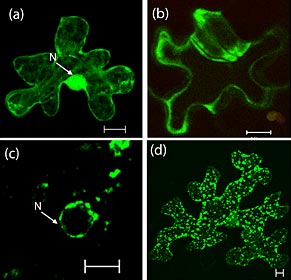Discover important plant enzymes
Scientists from the Brookhaven Laboratory - the US Department of Energy have found important enzymes involved in the conversion of isoflavonoids - natural plant products that help plants avoid fungal infections. They can be beneficial to human health.
The study was published online May 22, 2008 in The Plant magazine. The study will probably lead to a way to transplant the isoflavonoid synthesized into bioenergy crops to increase resistance, reduce crop damage, and increase yields for other chemical materials.
Using the method described in the paper, the researchers identified enzymes that alter the structure of plant cell walls. They play a very important role in changing the digestibility of cell walls, producing biomass suitable for conversion into biological materials.
In nature, isoflavonoid occurs mainly in legumes such as clover, soy, and alfalfa. It increases plant tolerance to disease, helps maintain symbiotic relationships between plants and microorganisms that live in their roots to produce biomass. Some studies also suggest that these natural plant products can prevent some cancers, cardiovascular disease, and menopausal symptoms.

When the Brookhaven team marked the isoflavonoid enzyme with a green fluorescence protein, they were surprised to find the marked enzyme in the plant cell nucleus (a).This is the difference in the normal distribution of other enzymes with them (c), which suggests that there is a potential undetected biological function of enzymes in the cell nucleus.When this protein shrinks, it is impossible to determine the position of the nucleus anymore (b), revealing another form of distribution (d).(Photo: Brookhaven National Laboratory)
Brookhaven Chang-Jun Liu, biologist, author of the paper said: 'Many people are interested in transplanting isoflavonoids into non-legume plants to benefit both plants and humans. '
This is not a simple job. First, isoflavoniod biosynthesis is complex, with many steps and requires the participation of many enzymes. Another challenge is the high concentration accumulation for intermediate molecules can be toxic to plants.
Liu said: 'The legumes have found a protective measure by transferring the accumulation of intermediate molecules into vacuoles or cell walls'. The enzyme that performs this metabolism is the enzyme Liu wants to find.
Liu and co-authors deduced that the enzyme may belong to a large family of enzymes that perform many biological functions that affect the growth, development, resistance, biosynthesis, as well as alteration. change cell wall structure. So they started looking for genes that instruct cells to make the protein group.
Fortunately, the gene that produces that protein group has the same sequences of genetic information. Using the 'sign' sequence as a map, scientists have looked for genes that have similar signs in the genetic data of a legume. The first search produced 76 types of genes that seemed to belong to this group of genes, including genes that instruct cells to produce isoflavonoid enzymes.
Based on bioinformatics analysis and genetic testing, scientists focused on 9 genes. They then implanted these 9 genes into E. coli to produce proteins, then tested the proteins' ability to function enzymatically. Scientists have discovered three enzymes with the reactions they are looking for - converting the intermediate molecule in the biosynthesis isoflavonoid into a form that can be stored by adding short carbon sequences, the process. called acylation.
The next step is to test these three acylated enzymes in plants. The scientists added the genes of each enzyme to conventional plants in the laboratory environment, not legumes, that contained some incomplete isoflavone-forming genes, eventually examining acylated isoflavonoid products. .
Liu explained: 'Using this method, we were able to confirm that at least one enzyme has an acyl reaction to plant isoflavonoid'.
In addition to finding enzymes, experiments have shown that researchers have successfully implanted isoflavonoids in non-legume plants, making the prospect of biosynthesis into progressive bioenergy crops. closer to reality.
Liu said: 'The enzymes we found clearly made a lot of chemical changes that have similar structures. They can be used in metabolic applications of value-added chemical materials by promoting chemical accumulation in bioenergy crops. '
The study was co-sponsored by the Science Department of the US Department of Energy's Biological and Environmental Research Agency in collaboration with the Brookhaven Research and Development Program. In addition to Liu, the research team included Xiao-Hong Yu, a postdoctoral researcher working at Brookhaven Laboratories, and Min-Huei Chen of Stony Brook University.
- Liver enzymes are high and how to reduce them without medication
- 8 ways to reduce liver enzymes simply can be done
- The culprit causes an increase in liver enzymes
- Cigarette smoke will inhibit anti-inflammatory enzymes
- High liver enzymes - close assassins
- The cow's stomach holds the secret to turning corn into biofuel
- Detection of enzymes involved in early cancer
- Biofuel comes from beef intestines
- Important discoveries about viruses that cause AIDS
- Liver enzymes are high - a threat of Tet holiday
- Identification and development of new enzymes
- Prevent the impact of chemical weapons by squid
 Why do potatoes have eyes?
Why do potatoes have eyes? 'Tragedy' the world's largest carnivorous life: Death becomes ... public toilet
'Tragedy' the world's largest carnivorous life: Death becomes ... public toilet Tomatoes were once considered 'poisonous' for 200 years
Tomatoes were once considered 'poisonous' for 200 years Detecting microscopic parasites on human face
Detecting microscopic parasites on human face